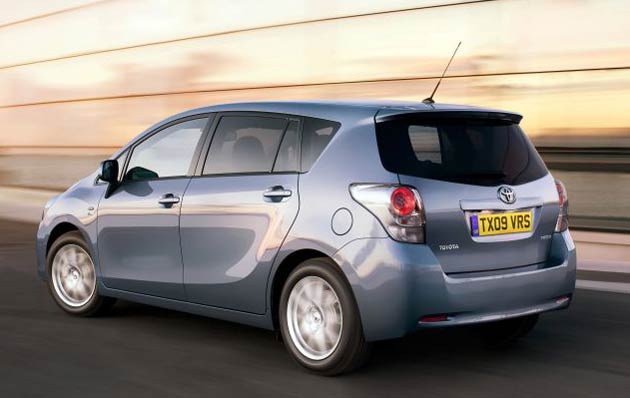Toyota Verso
Has all the progress in the new Toyota Verso been made in quite the right direction?

It's a dual-zone dynamic lounge. And you thought it was just a car. Maybe you thought, justifiably, that the outgoing Toyota Corolla Verso compact MPV was a bit of a dullard, but this new one – no longer a part of the Corolla range but instead a stand-alone model – won't let you think such thoughts for a second. That's the idea, anyway.
Two zones. Zone One is the bonnet and cabin. Zone Two is the chassis and boot space. That's the visual distinction, anyway, as defined by the line that starts low ahead of the front wheels and finishes at the top of the back window. As a practical distinction it's hopeless, of course, because why would you want the engine with you in the cabin and why banish your luggage to the chassis?
But let us not quibble. Instead, let us enter the Dynamic Lounge which means, well, that this is a roomy MPV with foldable/slideable seats including a disappearing rearmost pair, an air of techy futurism and the quiet, comfort and dynamic panache of a lower, more sporting, more "premium" machine. Grand claims indeed.
The concept-stage drawings of the Verso showed a desirable-looking family-transport module, sleek, simple and futuristic. The production version would have stayed true to the concept had the designers been able to stop fiddling with the front, which has ended up fussy and overwrought. That apart, there's a pleasing clarity to the design although drama has sometimes triumphed over function.
Prices range from £16,745 to £20,670, and three engines will be offered initially. The 147bhp, 1.8-litre petrol unit has variable valve-lift able to emulate the function of the throttle, so like the BMW engines of similar configuration it is potentially very economical because there isn't a separate throttle to disrupt the airflow and cause pumping losses. BMW calls it Valvetronic; Toyota calls it Valvematic. The two diesels are a 2.0-litre with a lowly 126bhp and a 2.2 with 148bhp, both of them with plentiful torque.
Now, I must confess an interest here. In our family we have the original Corolla Verso, a 2001 diesel example which was one of the first in the UK. This model's British sales career was short, ending in 2004 when the second generation appeared with its bigger body and seven seats.
That later car, like the subject of this test, was made in Turkey rather than Japan. I was not a fan; it felt bulky, an impression helped by a low driving position which seemed to negate one of an MPV's advantages. Toyota tacitly admitted problems of forward vision by offering a camera built into the nose to help with close-quarters manoeuvring. My wife disliked it, and much preferred her early version – a car which is something of a forgotten MPV champion by being delightful to drive apart from its noisy diesel engine, very useful because its seats (just five, admittedly) are fully removable, and unfailingly dependable.
And the new one? The driving position has been made right again, so you're in command with a great view out. It is smooth and quiet, the 2.0-litre diesel miraculously so compared with our family car's, and it flows well through bends so the family will be comfortable on a twisting road. Its steering lacks the subtlety of the early car's, but it's good for an electrically powered system and has the possible benefit of applying helpful corrective effort should you get into a skid.
And look at that dashboard. It has, yes, Smart Wave Dynamism, in which a centre console and a central instrument pod sit on top of a wavy backdrop. It looks restful and futuristic. But our old Verso has a useful storage box on top of its dashboard, plus myriad storage compartments within the dashboard and lower console that the new car largely lacks. For family clutter, Verso Version 1.0 wins hands down.
Safety standards have something to do with this, because they rob storage space and give it over to more structure and padding. The new Verso even has full airbaggery for the rearmost passengers, who get slightly more space than they got in Version 2.0's cramped aft end. As with that car, though, the centre seats merely fold flat instead of also being able to tumble forward or come out altogether.
Of course, the latest Verso is overall the best of the three, with the sweetest and most frugal engines, the best looks (nose excepted) and, optionally, an excellent automatic option for the petrol engine which is one of the better continuously variable systems I have tried. But then I get back into our faithful family wagon, and I find myself wondering if all the progress has been in quite the right direction.
THE RIVALS
Citroen Grand C4 Picasso 1.6 HDi: from £17,795
Huge windscreen is not to everyone's taste, but a versatile, upmarket seven-seater. Dull to drive.
Ford S-Max 1.8 TDCi: from £19,995
The keen driver's favourite MPV, a kind of Galaxy coupé but still with seven viable seats. Looks good, feels great, but it's awkwardly wide.
Honda FR-V 2.2 i-CTDi: from £18,411
Recently facelifted, the FR-V has two rows of three seats with the centre ones set further back. Clever design that's practical and good to drive.
Join our commenting forum
Join thought-provoking conversations, follow other Independent readers and see their replies
Comments
Bookmark popover
Removed from bookmarks